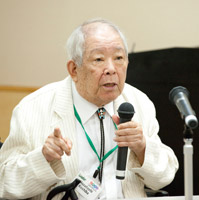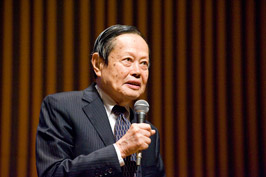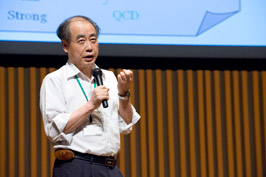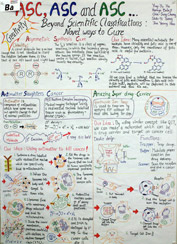 |

Student Participants of 2009 ASC.
|
The Tsukuba International Congress Center, Epochal Tsukuba, was the scene Aug. 2-8 of a gathering of about 200 students from all over Asia, who were in Japan for the 2009 Asian Science Camp.
The purpose of the annual event is to give the region's top students a chance to interact with eminent scientists, including Nobel prize winners, and at the same time give them experience in collaborating with people from different cultures and backgrounds.
The idea for the Asian Science Camp arose when Dr. Masatoshi Koshiba and Dr. Yuan T. Lee were attending the Lindau Science Meeting in 2005. Lindau was a valuable experience, Dr. Lee recalls, but "we looked around and realized that there were very few Asian students there. Also, we thought it would be valuable to involve younger students."

Dr. Masatoshi Koshiba, Nobel Laureate in Physics, 2002.
|
 |
They thought that if they could get some of the top scientists in the region involved, it could be a powerful incentive for the best science students in Asia to come and meet them. The idea met with a positive reception, and the result has been three successful camps, in Taipei in 2007, Bali in 2008, and this year in Tsukuba.
The host institutes of this year's event were the Heisei Foundation for Basic Science, KEK and the International Center for Elementary Particle Physics (ICEPP), the University of Tokyo in association with Japan's Ministry of Education, Culture, Sports, Science and Technology, and NHK (Japan Broadcasting Corp.).
The leaders were: Rajagopala Chidambaram, Principal Scientific Advisor to the Government of India; Leo Esaki, Nobel Laureate in Physics, 1973; Makoto Kobayashi, Nobel Laureate in Physics, 2008; Masatoshi Koshiba, Nobel Laureate in Physics, 2002; Yoshihide Kozai, Director of Gunma Astronomical Observatory; Yuan T. Lee, Nobel Laureate in Chemistry, 1986; Ryoji Noyori, Nobel Laureate in Chemistry, 2001; Koichi Tanaka, Nobel Laureate in Chemistry, 2002; and Chen Ning Yang, Nobel Laureate in Physics, 1957.
The program consisted of plenary lectures by each of the nine leaders; the "camps" (small seminars hosted by the leaders); lab tours and excursions; and poster creation and presentation sessions by the students. The students were divided into 40 teams, which stayed together as they participated in the camp activities.
Science today requires cooperation among researchers in a variety of fields, so the ability to collaborate with people from various countries and fields is crucial. A good example is climate change, one of the most serious problems facing humankind, and one that many of the participants in the camp will surely be called upon to help solve at some point in their careers. Topics along these lines at ASC09 included "Green Chemistry" by Dr. Noyori and "Scientific Challenges for Energy Research," by Dr. Chidambaram.
 |

Dr. Chen Ning Yang, Nobel Laureate in Physics, 1957.
|
The camp seminars were small, about 30 students each, allowing plenty of interaction with the leaders and lively in-depth discussions. Topics ranged from the light and thought-provoking, such as Dr. Esaki's "How to Win a Nobel Prize," to high-level theoretical concepts, like Dr. Kozai's "Gravitational Lens," and Dr. Koshiba's "Universe, Mankind and Elementary Particles."
Most of the students were considering careers in science, so they relished the chance to hear some very successful scientists talk about their careers and the attributes that helped them rise to the top of their field. Dr. Yang's "Stories about Some Great Physicists," Dr. Tanaka's "Discussion on Creativity by Ignoring Scientific Classifications," and Dr. Lee's "My Personal Experiences of Being a Scientist" were met with rapt attention.

Dr. Makoto Kobayashi, Nobel Laureate in Physics, 2008.
|
 |
The camps also dealt with the latest science topics, such as Dr. Koshiba's discussion of his Nobel-winning work in his lecture "Neutrino, Neutrino and Neutrino." Dr. Yang held a camp on "Thematic Melodies of 20
th Century Theoretical Physics," on the revolution that resulted from quantum mechanics, symmetry and the concept of phase, which he calls the three fundamental "melodies" of 20
th century physics. Dr. Kobayashi spoke on "Flavor of Quarks and Leptons," and Dr. Kozai on the "Atmosphere of Venus, Mars and Earth," and "Gravitational Lens."
The Wednesday of ASC09 week was devoted to excursions around Japan and tours of labs. One group of students made the long bus ride to the town of Hida, Gifu Prefecture, to visit the Super Kamiokande neutrino detector. Others went on tours of research facilities in the Tsukuba area, including particle accelerators at KEK, the space center at JAXA (the Japan Aerospace Exploration Agency), and labs at AIST (the National Institute of Advanced Industrial Science and Technology), as well as trips into Tokyo.
The culmination of the camp was the poster creation and display session.
The teams were required to create a poster to show their understanding of the lectures and camps and the ideas they generated, using text and graphics to make a visually pleasing and informative presentation. The posters were then hung in the Multipurpose Hall, and as leaders, helpers and other students walked by, the poster creators discussed their ideas with them.
Ten posters were selected for presentation in the Main Hall; the presentations were fluent and thorough, and sparked some lively discussions. The judges then evaluated the posters based on their originality of ideas and presentation, the team's presentation and discussion, their use of key concepts from the lectures, and the level of team cooperation.
 |

Gold Prize Poster by Team Ba.
|
The winning poster was "ASC, ASC and ASC," an interesting thought experiment that combined topics covered at the camp into speculative but plausible ways to cure human diseases. The title (a play on the title of Dr. Koshiba's lecture, "Neutrino, Neutrino and Neutrino" and "Asian Science Camp"), had three sections: "Asymmetry Synthesis Cure," in which inverting certain molecules' symmetry would change their chemical properties, depriving pathogens of nutrients, thus curing the disease; "Antimatter Slaughters Cancer," a method of destroying tumor cells by injecting them with antimatter, which would be annihilated when it came into contact with matter, emitting gamma rays and destroying the cancerous cells; and "Amazing Super drug Carrier," a nano-size robot that could be injected into the body to target cancerous tissue with a sensor, then inject single molecules of medication to destroy the tumor cells.
The poster was both interesting and rather funny in parts. "The humor was a big part of it," said Ramya Balaji, one of the winning team members. "We started talking and brainstorming and laughing about it, and these silly ideas came out, like trying to make it all 'ASC,' and it all came together."
One silver medal went to "Superlattice, Superhuman, Supergeneration," an interdisciplinary approach to creating artificial limbs, eyes and skin. The other went to "Matter Matters," about problems waiting to be tackled by the next generation of scientists, such as dark matter, antimatter and the unification of the four forces.
Bronzes went to "Pierces through the Clouds," about telescope technologies and the new era of astronomy; "Similarity, Similarity and Similarity," on how structures in nature inspire scientific innovations, and "Carbon Reduction Technologies," on ways to reduce carbon dioxide in the atmosphere.
The most important aspect of the poster-making sessions was that it was a chance for students from different parts of Asia to bond around a common purpose.
Ms Balaji said, "The poster-making session was a time I shall treasure forever. My team had such a good time discussing the lectures and coming up with some really creative ideas and then brainstorming them to develop our poster. The moment I cherish the most was when the medal was put around my neck, because there could have been no better place to win it in."
Another member of the winning team, Jae Yeong Heo, said, "I was astonished by the ideas the other members came up with, and even though each of us had different ideas, we didn't collide. Our gold medal was the result of the union of our various innovative ideas."
On the Friday night the entire group attended a farewell party and banquet for a last chance to meet and talk with new friends. The party was graced by the presence of their Highnesses the Emperor and Empress of Japan, who visited to chat with some of the students and discuss their posters. The Emperor takes a special interest in science and science education.
The 2009 Asian Science Camp was judged a thorough success by everyone involved. The event appears to have a healthy future ahead of it as well, with other countries showing interest in sponsoring it, including the Indian government, which has proposed holding it next year in Mumbai. South Korea has offered to host it the year after that.
"The main value of the science camp," noted Dr. Koshiba, the driving force behind this year's camp, "is that it exposes young people to different cultures and ways of thinking. In this globalized culture, that is very important. ... No one knows what the future will bring. So our hope is that these camps will help science-oriented young people find inspiration and a direction in scientific research."
Robert Cameron



